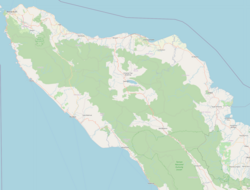Baitul Makmur Meulaboh Grand Mosque
Nowadays, Baitul Makmur Meulaboh Grand Mosque is a topic that has gained great relevance in today's society. Its impact has become evident in various areas, from politics to popular culture. Over time, Baitul Makmur Meulaboh Grand Mosque has become a point of interest for experts and the general public, generating debate and reflection on its implications. In this article, we will explore in depth the meaning and importance of Baitul Makmur Meulaboh Grand Mosque, as well as its influence on our daily lives.
| Baitul Makmur Meulaboh Grand Mosque | |
|---|---|
Masjid Agung Baitul Makmur Meulaboh | |
 The mosque in 2014 | |
| Religion | |
| Affiliation | Islam |
| Location | |
| Location | Seuneubok Village, Johan Pahlawan District, Meulaboh, West Aceh Regency, Aceh, Indonesia |
| Geographic coordinates | 4°09′32″N 96°07′29″E / 4.158785°N 96.124813°E |
| Architecture | |
| Type | Mosque |
| Style | Arabic, Indian, Acehnese |
| Completed | 1999 |
Baitul Makmur Meulaboh Grand Mosque (Indonesian: Masjid Agung Baitul Makmur Meulaboh) is the largest mosque in the western coast of Meulaboh, Aceh, Indonesia.
Architecture

The mosque has an architectural style of a combination of Arabic, Indian, and Acehnese, as well as a selection of bright brown colors combined with red brick on the dome of the mosque. The main characteristics of the mosque are three main domes flanked by two water tower domes of smaller size. The head shapes of all the domes are the similarly rounded and has pointed end, typical of Islamic architecture with the Middle Eastern and Asian blend.[1] This mosque will be equipped with two new towers which is still under construction as of 2012. The inspiration of the Middle Eastern architectural style is also evident from the form of mihrab. The mihrab is dominated by brown color and shades of gold typical of bronze material with Islamic special ornaments.
The combination of the architectural characteristics has made the Great Mosque of Baitul Makmur Meulaboh entered into the 100 Most Beautiful Mosque in Indonesia, a book compiled by Teddy Tjokrosaputro & Aryananda Published by PT Andalan Media, August 2011.[2][3]
See also
References
- ^ Baitul Makmur Great Mosque Archived 2013-02-07 at the Wayback Machine. www.duniamasjid.com. Retrieved 23 July 2012
- ^ Masjid Agung Meulaboh Login 100 The Most Beautiful Mosque. Www.aceh.tribunnews.com. Retrieved 23 July 2012
- ^ Grand Mosque of Baitul Makmur Meulaboh Includes 100 Most Beautiful Mosques. Www.acehbarat.com. Retrieved 23 July 2012



